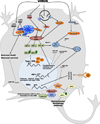Innate immune interactions within the central nervous system modulate pathogenesis of viral infections
- PMID: 26163762
- PMCID: PMC4593735
- DOI: 10.1016/j.coi.2015.06.011
Innate immune interactions within the central nervous system modulate pathogenesis of viral infections
Abstract
The innate immune system mediates protection against neurotropic viruses that replicate in the central nervous system (CNS). Virus infection within specific cells of the CNS triggers activation of several families of pattern recognition receptors including Toll-like receptors, retinoic acid-inducible gene I like receptors, nucleotide-binding oligomerization domain-like receptors, and cytosolic DNA sensors. In this review, we highlight recent advances in our understanding of how cell-intrinsic host defenses within the CNS modulate infection of different DNA and RNA viruses.
Copyright © 2015 Elsevier Ltd. All rights reserved.
Figures

Similar articles
-
Innate antiviral signalling in the central nervous system.Trends Immunol. 2014 Feb;35(2):79-87. doi: 10.1016/j.it.2013.10.012. Epub 2013 Dec 6. Trends Immunol. 2014. PMID: 24316012 Review.
-
Extracellular Vesicles Deliver Host and Virus RNA and Regulate Innate Immune Response.Int J Mol Sci. 2017 Mar 20;18(3):666. doi: 10.3390/ijms18030666. Int J Mol Sci. 2017. PMID: 28335522 Free PMC article. Review.
-
The Yin and Yang of Antiviral Innate Immunity in Central Nervous System.Curr Pharm Des. 2016;22(6):648-55. doi: 10.2174/1381612822666151204001550. Curr Pharm Des. 2016. PMID: 26635264 Review.
-
Recognition of viral nucleic acids in innate immunity.Rev Med Virol. 2010 Jan;20(1):4-22. doi: 10.1002/rmv.633. Rev Med Virol. 2010. PMID: 20041442 Review.
-
Innate and intrinsic antiviral immunity in skin.J Dermatol Sci. 2014 Sep;75(3):159-66. doi: 10.1016/j.jdermsci.2014.05.004. Epub 2014 Jun 2. J Dermatol Sci. 2014. PMID: 24928148 Review.
Cited by
-
Antiviral response within different cell types of the CNS.Front Immunol. 2022 Nov 15;13:1044721. doi: 10.3389/fimmu.2022.1044721. eCollection 2022. Front Immunol. 2022. PMID: 36458002 Free PMC article. Review.
-
Expression Profiling and Bioinformatics Analysis of CircRNA in Mice Brain Infected with Rabies Virus.Int J Mol Sci. 2021 Jun 18;22(12):6537. doi: 10.3390/ijms22126537. Int J Mol Sci. 2021. PMID: 34207166 Free PMC article.
-
It's a TRIM-endous view from the top: the varied roles of TRIpartite Motif proteins in brain development and disease.Front Mol Neurosci. 2023 Dec 5;16:1287257. doi: 10.3389/fnmol.2023.1287257. eCollection 2023. Front Mol Neurosci. 2023. PMID: 38115822 Free PMC article. Review.
-
Intrauterine Viral Infections: Impact of Inflammation on Fetal Neurodevelopment.Front Neurosci. 2021 Nov 10;15:771557. doi: 10.3389/fnins.2021.771557. eCollection 2021. Front Neurosci. 2021. PMID: 34858132 Free PMC article. Review.
-
Deep Proteomics Network and Machine Learning Analysis of Human Cerebrospinal Fluid in Japanese Encephalitis Virus Infection.J Proteome Res. 2023 Jun 2;22(6):1614-1629. doi: 10.1021/acs.jproteome.2c00563. Epub 2023 May 23. J Proteome Res. 2023. PMID: 37219084 Free PMC article.
References
-
- Knipe DM, Howley MP, editors. Fields Virology. Wolters Kluwer Health/Lippincott Williams & Wilkins; 2007.
-
- Schweighardt B, Atwood WJ. Virus receptors in the human central nervous system. J Neurovirol. 2001;7:187–195. - PubMed
Publication types
MeSH terms
Substances
Grants and funding
LinkOut - more resources
Full Text Sources
Other Literature Sources
Medical

